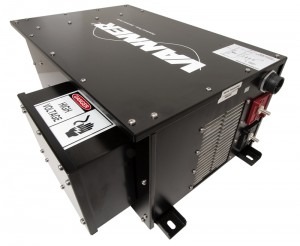 The strong trend toward vehicle electrification, whether for a hybrid, full electric or hydrogen fuel cell vehicle, is smart if it takes advantage of energy efficiencies. Hybrid benefits that help justify the investment include improvements in operational cost, reduced noise and conservation of resources.
The strong trend toward vehicle electrification, whether for a hybrid, full electric or hydrogen fuel cell vehicle, is smart if it takes advantage of energy efficiencies. Hybrid benefits that help justify the investment include improvements in operational cost, reduced noise and conservation of resources.
Vanner Inc., Hilliard OH, has partnered with a major supplier and myriad customers to develop technology that contributes to electrification of hybrid buses. The company develops power management solutions for the hybrid bus market. Vanner says it has made electrification an integral part of its business strategy with OEMs and transit authorities to ensure the new technology meets commercial needs.
With the recent introduction of Vanner Hybrid Beltless Alternator™ (HBA™) for the Allison H40EP and H50EP Hybrids, Gillig Bus, Hayward, CA, has taken a leadership role as the first OEM to offer the hybrid beltless alternator technology on its buses. Now the majority of the North American transit bus OEMs are also offering this technology, demonstrating the impact.
Technology Problem Solver for the Bus Industry
Today’s hybrid systems make the leap in propulsion technology necessary to reduce fuel consumption. However, there is still room for improvement in efficiency and operational cost savings. The high voltage DC-DC converter technology that powers all accessory loads currently supported by the alternator has the power output to run the latest electric cooling fans requested by the transit authorities.
The successful collaboration between Vanner and Allison Transmission launched a hybrid beltless alternator product in early 2011. The technology includes a 250 amp-at-idle version and a larger capacity 300 amp-at-idle for hybrid transit buses, which provides enough electrical capacity to power the latest electric radiator cooling fans for additional fuel saving and reduced maintenance.
Prior testing in Death Valley, CA, indicated efficient operation in harsh environments and continued field trials with six transit authorities assisted in advancing this technology.
To date, transit agencies using this technology report little or no maintenance with the HBA™. They also indicate the technology more than pays for itself over the life of the bus by improving vehicle up-time and reducing maintenance costs.
“We have been running the HBA™ on two of our buses,” says Max Camper, Warranty and Compliance Coordinator at the Central Ohio Transit Authority. “We install it and we forget about it. We haven’t had a single maintenance issue since its installation one year ago.”
The HBA™ converts DC power from the output of a high-voltage motor to supply 24V power to the electrical accessories. Hybrid systems designed with this technology supply power for electrical accessories with a solid-state device instead of a mechanical device with lots of moving parts.
Advantages of electrically powered components
Electrification of hybrid buses makes sense if the overall energy efficiency is greater than its mechanical counterpart. For example, the current oversized mechanical belt-driven alternators on buses are necessary to compensate for their low speed inefficiencies.
The benefits Of DC Power
The HBA™ converts DC power from the output of a high-voltage motor to supply 24V power to the electrical accessories. Hybrid systems designed with this technology supply power for electrical accessories with a solid-state device instead of a mechanical device with lots of moving parts.
Solid-state technology is a more efficient with a stable DC power source than traditional mechanical solutions and less susceptible to temperature changes. Powering accessory loads with the hybrid beltless alternator technology is 25-30 percent more efficient than with traditional alternators. In addition, removing the alternator removes the high-maintenance, belt-driven components including the alternator, V-belts, voltage regulator, pulleys, belt tensioner, and hydraulic oil lines.
Hybrid beltless alternator technology also eliminates air ducts, required to cool alternators in high-temperature, which reduces the cost of a new bus.
Patented power conversion technology
With Vanner’s patented power conversion technology the Hybrid Beltless Alternator™ (HBA™) can combine with J-1939 CAN-Bus communication and battery equalizers. Internal MBBM™ battery monitoring creates a “closed loop” system for hybrids that manages high-voltage and low-voltage batteries as one cohesive system.
The combination of the Vanner HBA™ and Vann-Bus® Battery Equalizer provides the next level of power management for the hybrid bus. Bus OEMs benefit from the ease of integration into their existing Allison Hybrid systems. Transit authorities benefit from the increased low-voltage battery life and prognostic maintenance information available to reduce maintenance costs and improve overall system reliability. The J-1939 CAN-Bus communication provides the capability to communicate with on-board telemetry systems, to broadcast ‘real-time’ notification of critical information from the electrical system.
DC to AC power conversion
The DC to AC inverter represents the next step in the evolution of hybrid power conversion to electrify the air conditioning compressor, power steering pump and the water pump.
Electrically driven compressors and pumps sealed at the motor require less maintenance, and are more reliable than mechanically driven compressors and pumps.
Plugged into the grid
The final step in the electrification evolution is to plug the hybrid vehicle into the electric power grid (PHEV), which requires converting AC to DC power from a controlled rectifier to create a variable supply of electrical power from the power source. Plugging into the grid can serve a variety of functions, such as cool-down of transit buses in warm climates, saving on daily idling hours.
Hybrid Beltless Alternator™ technology will be on display by Vanner and collaborators at Buscon, Chicago, IL, and APTA Expo, New Orleans, LA in fall 2011.
Chris Collett formerly served as Vice President, Bus and Hybrid Market for Vanner Inc, Hilliard, OH.
Experience Power…Experience Vanner!
More Information: info@vanner.com
Follow Us on Twitter: @VannerInc

